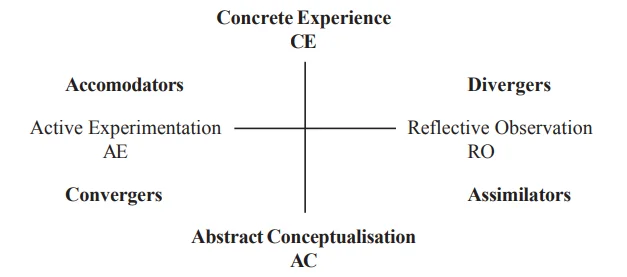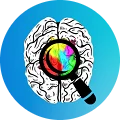Introduction
Learning styles are characteristic strengths and preferences of the learners for responding to the stimuli in the environment and processing the information. It is a behavioral pattern development for any new learning.
American Psychological Association – APA definition – Individual differences in people’s preferred ways of organizing and processing information.
Though each psychologist defines the term ‘learning style’ in a different way, ‘Learning styles’ mainly focuses on the following characteristics:
1) A learning style is a set of behavioral patterns. Which include behaviors like –
- Characteristic
- Cognitive
- Affective
- Physiological
The overt behavior of a person reveals his/her learning style. The behavior is in terms of response to the learning environment. (David Kolb & David Wolfe, 1984)
2) Learning style is a ‘way’ or an ‘approach’ of learning. It describes ‘how’ a student learns.
3)These are persistent qualities in the behavior.
In brief, learning styles reflect the underlying causes of learning behavior. They help in determining the educational conditions under which the learner is most likely to learn. These are the ‘clues’, which reveal how the learner’s mind relates and responds to the world.
Families of Learning Styles
We can classify learning styles, i.e., the behavioral patterns in a number of ways. These ways of classification emerge as learning style theories. The main families of learning styles :
- Constitutionally based
- Cognitive Structure
- Personality Types
- Learning Preference
Constitutionally Based
Learning styles in this family mainly focuses on genetically influenced personality traits. At this level there are mainly environmental factors, which are least stable and easily influenced. We are going to discuss learning styles defined in the Dunn and Dunn model as well as Delineators by Gregorc.
Dunn and Dunn Model
Dunn, R. et al. (1979) proposed a ‘Learning Style’ theory considering instructional preferences and environmental factors.
They investigated the research within and outside the field of education. Moreover were concerned with how youngsters and adults learn. Kenneth Dunn and Rita Dunn found that 18 different elements from four basic stimuli affect a person’s ability to learn and retain. The four stimuli are:
- The immediate environment
- Their own emotionality
- Sociological needs
- Physical requirements
The fifth dimension is of cognitive style, i.e., psychological.
Gregorc’s Style Delineator
Anthony Gregorc created a bi-dimensional model by sorting people along two dimensions: abstract-concrete and sequential-random. According to him, people can find their relative strengths in four mind channels as –
- Concrete Sequential
- Abstract Sequential
- Abstract Random
- Concrete Random
Cognitive Structure
This family examines cognitive personality style, addressing an individual’s approach to adapting and assimilating information. This level is considered to be an underlying and relatively permanent personality dimension. Riding and Rayner’s Cognitive Style Analysis (CSA) falls in this category.
Riding and Rayner’s Cognitive Style Analysis (CSA)
Richard Riding and Stephen Rayner (1998) by their research on style differences developed the Cognitive Styles Analysis (CSA) consisting of over 30 styles.
They believe that style is divided into two dimensions.
- `One of them is wholist-analytic, i.e., the way in which an individual would organise information in parts or as a whole.
- The other dimension is verbal-imagery, i.e., the way in which an individual would represent knowledge in mental pictures or words.
Riding developed a software package of the CSA allowing the user to quickly and easily measure the cognitive style on both dimensions.
Personality Types
This category of learning styles aims at identifying the personality traits of learners. This category provides a structure for understanding human behavior and experience by outlining the dynamic interplay between ‘reversing’ motivational styles.
Apter Motivational Styles Profile (AMSP)
According to this theory, people are driven by eight core motivational states. Further organized into four pairs of opposite states. And are constantly moving through a dynamic pattern of reversals within each pair.
Psychological health and effectiveness is maximizzed when people are able to experience all eight states, and match their state to the demands of the situation.
At the heart of the Apter Motivational Styles Profile (AMSP) is the idea that our experience is shaped by a set of alternative ways of seeing the world. Specifically, four pairs of such opposite states have been identified.
These motivational styles are:
- Achievement (Serious)
- Fitting in (Conforming)
- Control and power (Mastery)
- Individualism (Self)
- Enjoyment (Playful)
- Freedom (Rebellious)
- Caring and affection (Sympathy)
- Collectivism (Other)
Jackson’s Learning Style Profiler
Charles J. Jackson and Lawty-Jones, M. (1996) developed the Learning Style Profiler (LSP). Which is a hybrid model of learning is based on personality, self-efficacy, goal orientation, emotional intelligence, and conscientiousness.
The five learning styles reflect different parts of the process of learning.
- High Sensation Seeker
- Goal Oriented Achiever
- Emotionally Intelligent Achiever
- Conscientious Achiever
- Conscientious Achiever
Myers-Briggs Type Indicator (MBTI)
Myers-Briggs Type Indicator (MBTI) is a widely used instrument for assessing student learning styles. The MBTI provides data on four sets of preferences, which result in 16 types.
The MBTI consists of 126 items used to measure the learner’s preferences. Each of the four types has a primary orientation towards the world, one which affects their ability to learn and to work.
The four dimensions are as follows:
- Extraversion versus Introversion
- Sensing versus Intuition
- Thinking versus Feeling
- Judging versus Perceiving
Learning Preference
Allinson and Hayes Cognitive Styles Index (CSI)
Cognitive style was assessed using the Cognitive Style Index (CSI). Allinson & Hayes (1996) designed an inventory of 38 items scored on a 3-point scale. It consists of true-uncertain-false to measure the intuitive-analytic dimension of cognitive style.
A score towards the maximum of 76 indicates a relatively analytic style, and a score towards the minimum of zero indicates a relatively intuitive style.
Kolb’s Learning Style Orientation

David Kolb’s (1984) experiential learning theory provides a model of learning and adaptation processes consistent with the structure of human cognition and the stages of human growth and development.
Honey and Mumford’s Learning Styles
Honey and Mumford (1992) developed the learning styles idea by producing a set of inventories based on Kolb’s work. They suggested that there are four styles:
- Activists
- Theorists
- Pragmatists
- Reflectors
Sensory Preferences/ Modalities
Leaver (1997) in her book, ”Teaching the whole class” stresses that learners have sensory preferences; the most common being visual, auditory, and motor. She further maintains that each of these has two possible variants.
What makes this issue complex is the fact that most learners have a primary modality and a secondary modality.
Things become difficult for a learner when he/she has a particular primary sensory modality but the teacher uses a different sensory modality for classroom teaching. Let us examine the characteristics of learners with different sensory modalities in detail.
Visual Learners
They learn easily and better through sight. Brightness, size, color, distance, clarity, frame and symmetry are important to visual learners.
Visual learners must see so that they may learn easily. They categorize as verbalists (they see words and letters) or imagists (they see images i.e. pictures).
While learning English, the verbalist will see ‘crown’ as ‘c-r-o-w-n’ while the imagist may see ‘crown’ as ‘a king wearing a crown’.
In order to distinguish between two homophones e.g. ‘son’ and ‘sun’, the verbalist will focus on the middle vowels (i-e. son and sun). But the imagist will associate ‘son’ with the image of ‘a boy standing by the side of his father’ and ‘sun’ with the image of ‘the rising sun’ or ‘the sun in the sky’
Auditory Learners
They acquire information through sound i.e. the ear gate. Various aspects of sound e.g. pitch, volume, tempo, rhythm, resonance are important for auditory learners.
Auditory learners may be aural (they learn by listening to others) or oral (they learn by talking and hearing themselves).
Unless the teacher provides these learners with adequate auditory input, they become frustrated and restless in the classroom. Auditory learners reveal their thought and thought processes through their speech.
Hence the teacher can easily identify these learners.
Motor learners
They learn through motor activity. Various aspects of action e.g. frequency, duration, intensity, pressure etc., are important for them. Motor learners may be kinesthetic (they learn through the use of gross motor muscles) or mechanical (they use fine motor muscles to support their learning).
Sensory preferences have an important message for wholeclass teaching. The teacher should provide for visual learners by developing a comprehensive blackboard summary, for auditory learners through his/her talk and for motor learners through activity-based teaching.
We can learn/teach effectively, if we use all sensory modalities.
Check your learning style –
Criticism on Sensory Preference Learning Style Theory
Researchers found that categorizing an individual into one learning style creates hindrance in learning.
In a Ted Talk, Marshik T. says that mostly what we’re learning in the classroom is much more conceptual, or meaning based. The Chase-Simon Chessboard experiment is an excellent example for this.
Further, there is another reason why this learning-styles theory doesn’t pan out. The reason is that the best way to teach something or to learn something really depends on what it is you want to learn. It depends on the content itself. It does not depend on the sensory mode of perception.
References
- Anderson, J. R. (2015). Cognitive psychology and its implications. New York: Worth Publishers
- Galloti, K. M. (2004). Cognitive psychology in and out of the laboratory. USA: Thomson Wadsworth.
- Matlin, M. (1994). Cognition. Bangalore: Harcourt Brace Pub.
- egyankosh.ac.in
Niwlikar, B. A. (2022, July 4). Learning Styles. Careershodh. https://www.careershodh.com/learning-styles-personality-genes-learning-preference/
